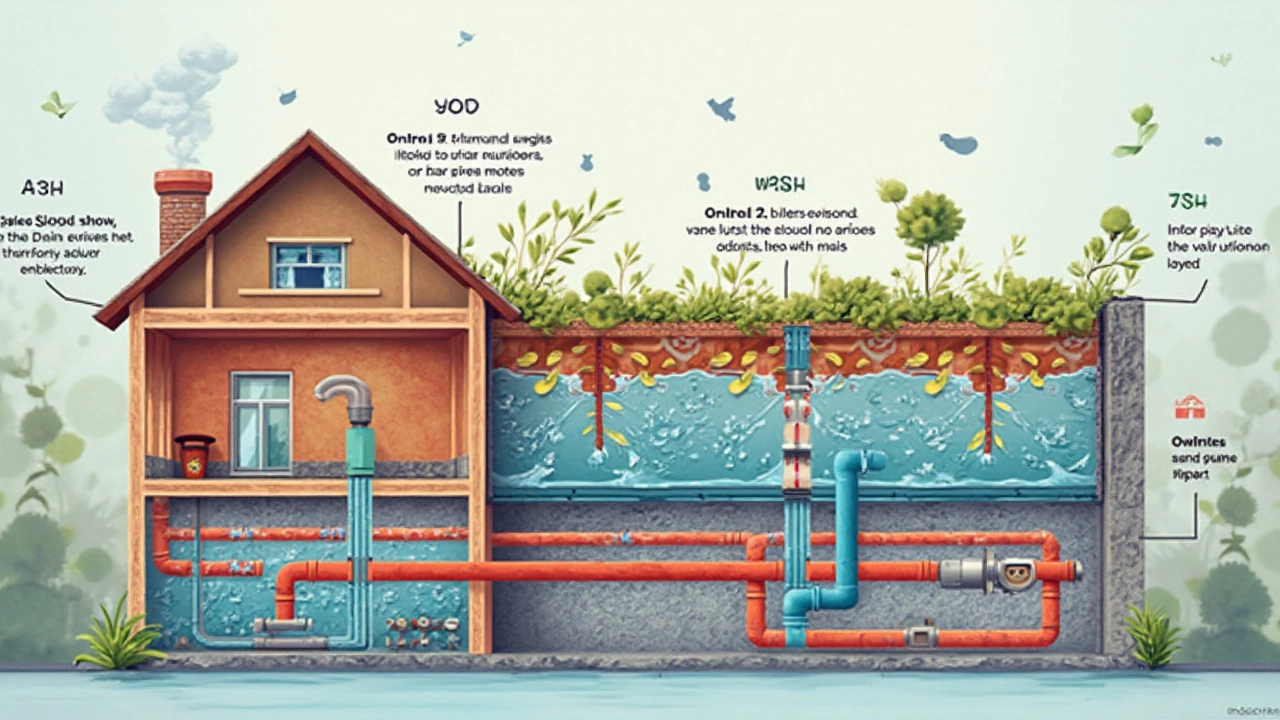Screwed-up drain slope is behind more plumbing disasters than you’d think. Mix up your numbers here and it doesn’t matter how fancy the fittings are—soon you’re dealing with pooling water, nasty blockages, or even sewage backups. Really, figuring out the fall of a drain is Plumbing 101, but a lot of people fudge it and end up paying for it later.
What does "fall" even mean? It’s just the downhill slope that pulls water and waste through a pipe using gravity. If you're thinking this is rocket science, don’t worry—the concept is dead simple, and you don’t need to remember any weird formulas from high school. Get it right, and your pipes stay clean and flow smoothly. Mess it up by making it too steep or too flat, and the problems pile up quick.
So, how do you actually calculate the right drop over say, three meters of pipe? You’ll want the right slope—not too much, not too little. Hang tight, because that’s exactly what we’re going to lay out, step by step, with easy math and real-life shortcuts for when you’re actually crawling under a sink or laying new pipes outside.
- Why Drain Fall Matters
- The Math Behind the Slope
- Step-by-Step: How to Calculate Drain Fall
- Common Mistakes and Pro Tips
Why Drain Fall Matters
If you’ve ever had a toilet that just doesn’t flush right or a shower that always gurgles, you’ve probably seen what happens when a drain fall is off. The whole point of the right slope, or fall, in your drain pipes is to keep water and waste moving smoothly with gravity. The sweet spot keeps stuff flowing, stops blockages, and prevents gross back-ups.
The magic number in plumbing is a slope of 1 in 40, or about 1/4 inch per foot (that’s roughly 6mm drop for every meter of pipe). Get too lazy and go flatter than that, and stuff just lingers, sticks, and eventually clogs. Too steep, and the water rushes ahead, but the solid waste gets left behind—and that’s where the stink starts. It’s a balancing act that plumbing training always hammers home.
Here’s why it matters in actual plumbing jobs:
- Clog Prevention: The main reason for a proper drain fall is to prevent blockages. If water can’t carry away all the waste, you’re snaking pipes constantly.
- Speed: Pipes with the right pipe slope clear out quickly after each use—no slow drains.
- Pipe Life: Stagnant water eats away at pipes fast, causing leaks and expensive repairs. The right fall keeps things moving and extends pipe life.
- Code Compliance: Building codes aren’t just nitpicking—most require the 1 in 40 slope for a reason. It makes your install pass inspection and avoids rework.
Check this out—a quick look at what happens at different slopes:
| Slope | Result |
|---|---|
| Too Flat (less than 1 in 60) | Slow flow, frequent clogs |
| Just Right (1 in 40 or 1/4 inch per foot) | Efficient drainage, minimal issues |
| Too Steep (greater than 1 in 20) | Water outruns solids, blockages possible |
So, when you’re working on drains, don’t guess the slope—measure it. Every successful plumber swears by it, and honestly, there’s no shortcut if you want a job to last more than a month.
The Math Behind the Slope
If you ever wondered how plumbers keep drains flowing, a lot of it comes down to nailing the drain fall. In plain terms, it’s about giving your pipe a steady "downhill" angle so gravity can do its job. But how steep should you go? Too much and the water outruns the solids, leaving clogs behind. Too little, and everything just sits there. Standards matter—most codes stick to a 1-in-40 or 1-in-50 rule for pipes up to 100mm (4 inches) wide. That’s about 2.5 cm (or 1 inch) drop for every meter (or about 4 feet) of pipe.
The official plumbing term is the "slope" or "gradient." You might see it written as a ratio—like 1:40 (which is the same as a slope of 2.5%). But don’t let that math scare you. Here’s how the numbers line up for common pipe sizes and lengths:
| Pipe Size (mm) | Recommended Slope (% / Ratio) | Drop per Meter |
|---|---|---|
| 50 | 2% (1:50) | 2 cm |
| 100 | 2.5% (1:40) | 2.5 cm |
So, for a 5-meter run of 100mm pipe, you’ll need a total fall of 12.5 cm (5 x 2.5 cm). See? Nothing wild. The key is matching the drain fall to your pipe size—bigger pipes move stuff easier, smaller ones need a bit more tilt.
Want a quick check? Use this rule: Slope% = (Drop in cm ÷ Run in m) x 100. Grab a measuring tape, figure out your "run" (length of the pipe), and do the math. Plenty of plumbers keep a little notepad or phone app handy so they don’t have to rely on memory.
The sweet spot is all about steady, predictable flow. Get the pipe slope too steep, and you’ll hear the gurgling—water is moving, but solids aren’t keeping up. Too flat, and you get standing water and smells. Trust me, it’s worth getting this part right the first time.

Step-by-Step: How to Calculate Drain Fall
If you’ve got even a basic tape measure and a spirit level, you’re pretty much set to nail your drain fall. The secret here is that plumbing codes worldwide (think the IPC and most others) usually want a minimum slope for horizontal pipes: 1/4 inch of fall per foot of pipe (about 21 mm per meter). This isn’t just a random rule—too little slope, and the gunk stays stuck; too much, and water outruns the solids. You want that sweet spot where waste, water, and gravity are working together.
- Measure Your Run Length
Grab a tape and measure the distance (the "run") your drain pipe covers from its start (like a shower or sink) to its end point (usually a stack or main sewer). Jot this number down in feet or meters. - Apply the Standard Slope
Use the golden rule: 1/4 inch per foot (or about 2%). For metric, that’s roughly 20-25 mm drop for every 1 meter of pipe. Multiply your run length by the fall per unit length. For example, a 4-meter pipe gets 4 x 25 mm = 100 mm fall. That’s your total drop from end to end. - Mark and Set Pipe Height
Figure out where the pipe starts and mark that height on the wall or stud. From there, measure down the total calculated fall and mark the end point. You now know exactly how high the pipe should be at both ends. - Check with a Level
Lay the pipe between your start and end points. Use a spirit level, ideally with a slope vial or even a smartphone app. Make sure your pipe slope matches your calculations all the way through—watch for any dips or high spots, because those can ruin the flow.
Here’s a quick table you can use if you want to double-check those numbers fast:
| Pipe Run (Meters) | Recommended Fall (mm) |
|---|---|
| 1 | 20-25 |
| 3 | 60-75 |
| 5 | 100-125 |
| 10 | 200-250 |
One last thing: Larger drains (like sewers) can sometimes go a touch flatter—about 1/8 inch per foot—because their flow volume keeps stuff moving. But for typical home jobs? Stick to the standard drain fall and you’re safe.
Common Mistakes and Pro Tips
The biggest drain fall mistake? Getting the pipe slope wrong—even seasoned plumbers slip up. Set the angle too shallow and water doesn't move, leaving behind sludge that'll block your drain quicker than you think. Too steep, and water races away before carrying solids, which then settle and clog up the line. The magic number most codes agree on? For a typical 100mm (4-inch) pipe, aim for a gradient of 1:60 to 1:80 (about 12-16mm drop per meter of pipe). Smaller pipes, like 50mm, need even more fall—closer to 1:40.
Here’s where folks mess up most often:
- Guessing the slope by eye. Unless you’ve got superhuman vision, grab a spirit level or a digital slope meter—and for longer runs, string lines are your friend.
- Not checking the length of the run. Even a tiny mistake in slope adds up big over 10 or 20 meters. Always measure both the total drop and horizontal distance so your math lines up.
- Ignoring drain fall requirements at connection points. The junction between the new pipe and the old stack can sneakily mess up your whole calculation if you don’t allow for the right drop.
- Compacting soil after laying the pipe. If the ground settles unevenly, so will your pipe. Always use compacted bedding before and after laying to keep that slope locked in.
Here are some quick pro tips that’ll save you in real life:
- If in doubt, measure twice. Even a 5mm drop missed on a long run can create a world of trouble.
- Water test new lines before covering up. Pour a few buckets at one end and watch how quickly water drains out the other. Slow drain? Double check your fall.
- Write your calculations on a scrap of pipe or tape and keep it at the site—not back at your van or in your phone.
- If your work needs to meet local codes (and it nearly always does), double check the minimum and maximum allowed slopes—they aren’t the same everywhere. A lot of plumbers get dinged for this on inspections.
To drive home how important getting drain fall right is, check out these typical DIY error rates:
| Common Mistake | % of DIYers Affected |
|---|---|
| Too little slope | 43% |
| Too much slope | 19% |
| Poor support/bedding | 28% |
| Wrong pipe alignment at connections | 10% |
One last thing: when you get the calculating drain slope part right, you spend way less time with drain rods and way more time doing the stuff you actually enjoy.
